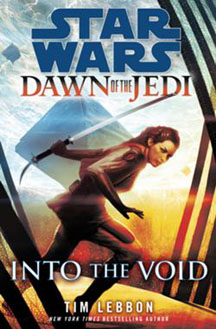Scientists are searching further back in space and time toward the Big Bang to gain a fuller picture of our universe. In a way, “Star Wars” fans do the same thing with each novel and comic we pick up. However, we’re further away from the “Star Wars” universe’s Big Bang than our own universe’s. In 2013, Tim Lebbon’s “Dawn of the Jedi: Into the Void” (now in paperback) became the earliest-set “Star Wars” novel by far, at 25,793 years before “A New Hope.” The previous oldest-set stories were John Jackson Miller’s “Lost Tribe of the Sith” series, set 5,000 years before “ANH.”
But “Dawn of the Jedi: Into the Void” will disappoint fans who want to learn the earliest origins of the “Star Wars” universe, or even the Jedi, despite its title. (Believe it or not, at one point there was a proposed story that would’ve told how humans got from modern Earth to the galaxy far, far away. Called “Alien Exodus,” and to be penned by Robert J. Sawyer, it was perhaps justifiably scratched in the planning stages. Do we really want “American Graffiti” to literally be part of the “Star Wars” universe? But it’s still utterly fascinating to think about.)
Still, Lebbon delivers some fascinating information about the longest ago (so far) portion of the galaxy far away, particularly in the way he uses established “Star Wars” words – either from official works or George Lucas’ “A New Hope” rough drafts – to construct several etymological origins. The Je’daii Rangers of Tython look upon two moons: Ashla and Bogan, which represent light and dark. While many Je’daii are humans and other familiar “Star Wars” races, some are of the Dai Bendu species. “Ashla,” “Bogan” and “Bendu” are words from Lucas’ drafts, and the names of the Je’daii temples scattered across Tython include the words “Kesh” (the planet in the “Lost Tribe of the Sith” series, and the home planet of Ben Skywalker’s girlfriend Vestara) and “Padawan” (the word for Jedi apprentice in the prequel era).
The “Dawn of the Jedi” era also has shades of “Firefly” in that all the action takes place in one star system: the Tythan System, with about a dozen habitable worlds. As with “Firefly,” the citizenry knows their origins are from elsewhere. On “Firefly,” citizens have vague knowledge of Earth-that-was; in “Dawn of the Jedi,” the Je’daii (as well as their non-Je’daii brethren, since the Force is not always passed on through the generations) know they came to Tython, a planet rich in the Force, a millennia earlier on pyramidal ships known as the Tho Yor. (These ships are now the Je’daii temples.) “Dawn of the Jedi” also has shades of “Stargate” in that the Stargazers – a cult that wants to leave the Tythan System and return to their ancestral homeworlds – possess a wormhole-creating device. But the device, which artificially creates dark matter, could also destroy the whole system, the Je’daii Masters fear.

That device is the central plot point of “Into the Void.” Force-hating Dalien Brock is working on perfecting the device, and his sister, obedient Je’daii Lanoree, aims to stop him. They engage in a cat-and-mouse chase throughout the system in what is a somewhat padded and hard-to-read novel. Lebbon packs in plenty of intriguing world-building – I haven’t even mentioned the Gree, the original inhabitants of the Tythan System – and does some decent pontificating on the Force via the central siblings. However, when you boil it down, there’s not a lot of story here.
Making it somewhat hard to read is the fact that Lebbon writes Lanoree’s flashbacks to her childhood in the Je’daii Temples with Dal in present tense, and he writes the present-day planet-hopping adventure in past tense. Lanoree is a likable enough character, as is her reluctant sidekick, the Twi’lek scoundrel Tre Sana. And Dal is a relatable villain: Lacking the Force, he has always felt apart from Je’daii culture and wants to find out where he came from. However, considering the wealth of “Star Wars” fiction out there, these characters don’t make much of an impact.
Essentially, “Dawn of the Jedi” is the latest example of a little corner of the “Star Wars” timeline and star map being carved out for one author (or a handful of authors, as Dark Horse Comics’ John Ostrander has written two “Dawn of the Jedi” volumes) to play in. We saw Miller do it with “Lost Tribe,” Drew Karpyshyn do it with the Darth Bane saga, and Mike Stackpole and Aaron Allston do it with X-wing pilots. That’s not really a criticism of “Dawn of the Jedi: Into the Void,” though. Yes, it raises more questions than it answers: Who is behind the Tho Yor spaceships and why did they gather up Force-sensitives and drop them on Tython? Why are Tython and its moons steeped in the Force? Will the stargate technology be used in future stories, before hyperspace travel comes about in the early “Tales of the Jedi” era? What is the relationship, if any, between the Gree and the Tho Yor?
But while this novel in and of itself isn’t a masterpiece, it is part of a larger tapestry known as “Star Wars” that we love because these questions and answers about space and time make it seem so vibrant and real. Those of us who have spent decades reading and enjoying “Star Wars” novels and comics intrinsically understand this. The folks over at Disney, who recently announced – while mincing words – that these decades of novels and comics won’t necessarily be factored into the continuity of future works, do not understand this.
As they plan their upcoming novels, comics, TV series (“Rebels”) and movies (“Episode VII” and beyond), they felt they needed a fresh start, paring the canonical universe back to the movies and “Clone Wars” TV series. But the rich tapestry of the hundreds of works already out there is the very reason we’ve loved “Star Wars” all these years, and “Dawn of the Jedi: Into the Void” is a particularly cool entry because it takes us so far back on the timeline. For those who want to read all the novels chronologically, it’s the beginning. How sad that, as far as the new keepers of the “Star Wars” holocron (Can I use the word holocron? Or is that not canon?) are concerned, it’s one of the last novels of the old way of doing things — the end of an era that Disney is dumping into the void.

